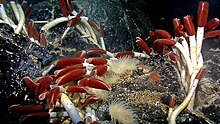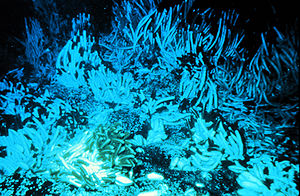巨型管蟲
| 巨型管蟲 | |
|---|---|

| |
| 科学分类 | |
| 界: | 动物界 Animalia |
| 门: | 環節動物門 Annelida |
| 纲: | 多毛綱 Polychaeta |
| 目: | 缨鳃虫目 Sabellida |
| 科: | 西伯加虫科 Siboglinidae |
| 属: | 巨型管蟲屬 Riftia |
| 种: | 巨型管蟲 R. pachyptila
|
| 二名法 | |
| Riftia pachyptila M. L. Jones, 1981
| |
巨型管蟲(學名:Riftia pachyptila)是西伯加蟲科下的一種生物[1]。它生活在太平洋一英里以下的海底熱泉附近,可以忍受富含硫化氢、水溫在2至30攝氏度之間的海水。其長度可達2.4米(7英尺10英寸),直徑約4厘米(1.6英寸)[2]。不同於生長速度極為緩慢的羽織蟲屬物種Lamellibrachia luymesi(170至250年間只能生長2米)[3],巨型管蟲生長速度極快,兩年內就可以長1.5米(4英尺11英寸)[4]。
發現[编辑]

巨型管蟲發現於1977年由地質學家傑克·科利斯乘坐阿爾文號深潛器前往科隆群島熱點探勘時所發現[5]。巨型管蟲的發現完全是個意外,當時的研究隊伍只是為了研究當地的海底熱泉,因此也沒有生物學家進駐。這次探勘還在海底熱泉附近發現了很多其他新物種。
由於阿爾文號深潛器搭載了機械手臂,因此也採收了許多生物的樣本,包括了雙殼綱、多毛綱、大型螃蟹以及約長 2 公尺的巨型管蟲個體[6][7]。
在這之後於中洋脊附近的海底熱泉也陸續發現了許多海洋生物,儘管熱泉附近的溫度可達 350 °C – 380 °C[8][9]。
生命史[编辑]
巨型管蟲剛孵化時為於遠洋帶可自行游動不仰賴共生的擔輪幼蟲,在發展為後擔輪幼蟲後轉為行固著生活,並開始仰賴共生細菌提供營養[10][11]。巨型管蟲體內的共生菌並未出現於管蟲的配子之中,而是在管蟲孵化後,透過類似感染的形式藉由皮膚自周遭環境吸收而得到。剛出生的巨型管蟲具有完整的消化系統,包括口、前段腸、中段腸、後段腸及肛門。在共生菌於中段腸建立群落後,中段腸會膨脹並形成營養體,而其他部分的消化系統則會退化。在成年巨型管蟲的體內,幾乎看不到有原本消化系統器官的殘留[12]。
身體結構[编辑]

若將巨型管蟲去掉外部由幾丁質組成的長管,其身體構造有別與傳統西伯加蟲科的前體部、中體部、後體部三分形式[13]。

巨型管蟲身體的第一部分被稱為鰓羽(Branchial Plume),主要負責提供營養給棲息於營養體內的共生細菌。其紅色來自於其中由至多144個血球素鏈組成的血紅素。這些血紅素最大的特徵在於能夠攜帶並運送硫化氫及氧氣,而大部分物種的血紅素並無此能力[14][15]。如果巨型管蟲受到來自外界的刺激,牠們會將鰓羽縮回至管中,並利用殼蓋將自己封閉於管內[16]。
巨型管蟲身體的第二部分稱為被套(vestimentum),由帶狀的肌肉所組成,帶有兩翼並在末端有兩個生殖孔[17][18]。膨大的背血管結構(功能類似於心臟)就位於被套之內[19]。
巨型管蟲身體的第三部分稱為軀幹部(trunk),包含了體壁、生殖腺以及體腔;軀幹部也是管蟲營養體的所在位置,營養體為海綿狀的組織,儲存了能提供管蟲營養的硫氧化細菌與硫顆粒[20][21]。由於成年巨型管蟲的嘴、消化系統與肛門均已退化,牠們所需的營養均必須由這些互利共生的細菌提供[22]。細菌在營養體中所進行的化能合成,最早是由科里·卡瓦納發現[22]。
巨型管蟲鰓羽中的血紅素具有攜帶並運送H2S及O2的能力,而體內的共生菌則能透過微血管獲得這些化學物質以進行化能合成[23]。在化能合成的過程中,粒線體酵素硫氰酸酶會催化硫代硫酸鹽S2O32-的歧化反應,生成S及亞硫酸鹽SO32-[24][25]。
硝酸鹽與亞硝酸鹽具有毒性,但是氮卻是生物合成的重要元素。位於巨型管蟲營養體內的化能合成細菌能將硝酸鹽轉化為銨離子,由細菌合成胺基酸並釋放給巨型管蟲。為了能將硝酸鹽運輸給細菌,巨型管蟲的血管內具有極高濃度的硝酸鹽,甚至為周遭海水硝酸鹽濃度的 100 倍。為何巨型管蟲能夠濃縮並承受如此高濃度的硝酸鹽,至今仍然未知[15]。
巨型管蟲身體的第四部分稱為後體部(opistosome),將個體固著於管內並用來儲存細菌化能合成後所產生的廢物[26]。
参考文献[编辑]
- ^ Ruppert, E.; Fox, R.; Barnes, R. . Invertebrate Zoology: A functional Evolutionary Approach 7th. Belmont: Thomson Learning. 2007. ISBN 0-03-025982-7.
- ^ Bright, M.; Lallier, F. H. The biology of vestimentiferan tubeworms (PDF). Oceanography and Marine Biology: An Annual Review (Taylor & Francis). 2010, 48: 213–266 [2013-10-30]. doi:10.1201/ebk1439821169-c4. (原始内容 (PDF)存档于2013-10-31).
- ^ Tube Worms In Deep Sea Discovered To Have Record Long Life Spans. ScienceDaily. [2018-05-19]. (原始内容存档于2019-08-12).
- ^ Lutz, R. A.; Shank, T. M.; Fornari, D. J.; Haymon, R. M.; Lilley, M. D.; Von Damm, K. L.; Desbruyeres, D. Rapid growth at deep-sea vents. Nature. 1994, 371 (6499): 663. doi:10.1038/371663a0.
- ^ Giant Tube Worm: Riftia pachyptila. Smithsonian National Museum of Natural History. [25 Oct 2018]. (原始内容存档于2018-10-24).
- ^ Childress JJ. Biology and chemistry of a deep-sea hydrothermal vent on the Galapagos Rift; the Rose Garden in 1985. Introduction. Deep Sea Research Part A. Oceanographic Research Papers. October 1988, 35 (10–11): 1677–1680. Bibcode:1988DSRA...35.1677C. doi:10.1016/0198-0149(88)90043-X (英语).
- ^ Lutz R. The biology of deep-sea vents and seeps: Alvin's magical mystery tour. Oceanus. 1991-01-01, 34 (4): 75–83 [2020-03-11]. ISSN 0029-8182. (原始内容存档于2019-12-22).
- ^ Exploring the deep ocean floor: Hot springs and strange creatures. (原始内容存档于2021-02-26).
- ^ Koschinsky A, Garbe-Schönberg D, Sander S, Schmidt K, Gennerich HH, Strauss H. Hydrothermal venting at pressure-temperature conditions above the critical point of seawater, 5°S on the Mid-Atlantic Ridge. Geology. 2008, 36 (8): 615. Bibcode:2008Geo....36..615K. ISSN 0091-7613. doi:10.1130/g24726a.1.
- ^ Bright M. Riftia pachyptila. [2015-03-19]. (原始内容存档于2015-04-02).
- ^ Adams DK, Arellano SM, Govenar B. Larval dispersal: Vent life in the ocean column (PDF). Oceanography. Mar 2012 [2020-03-12]. (原始内容存档 (PDF)于2015-04-02).
- ^ Jones ML, Gardiner SL. On the early development of the vestimentiferan tube worm Ridgeia sp. and Observations on the Nervous System and Trophosome of Ridgeia sp. and Riftia pachyptila (PDF). Biol Bull. Oct 1989, 177 (2): 254–276 [2020-03-12]. JSTOR 1541941. doi:10.2307/1541941. (原始内容 (PDF)存档于2015-09-23).
- ^ De Beer G. The Pogonophora. Nature. November 1955, 176 (4488): 888. Bibcode:1955Natur.176..888D. ISSN 0028-0836. doi:10.1038/176888a0.
- ^ Zal F, Lallier FH, Green BN, Vinogradov SN, Toulmond A. The multi-hemoglobin system of the hydrothermal vent tube worm Riftia pachyptila. II. Complete polypeptide chain composition investigated by maximum entropy analysis of mass spectra. The Journal of Biological Chemistry. April 1996, 271 (15): 8875–81. PMID 8621529. doi:10.1074/jbc.271.15.8875.
- ^ 15.0 15.1 Hahlbeck E, Pospesel MA, Zal F, Childress JJ, Felbeck H. Proposed nitrate binding by hemoglobin in Riftia pachyptila (Free full text). Deep-Sea Research. July 2005, 52 (10): 1885–1895. ISSN 0967-0637. doi:10.1016/j.dsr.2004.12.011.[永久失效連結]
- ^ Monaco A, Prouzet P. Marine Ecosystems: Diversity and Functions. John Wiley & Sons. 2015-10-02. ISBN 978-1-119-23246-9.
- ^ Desbruyères D, Segonzac M. Handbook of Deep-sea Hydrothermal Vent Fauna. Editions Quae. 1997. ISBN 978-2-905434-78-4.
- ^ Gibson RN, Atkinson RJ, Gordon JD. Oceanography and Marine Biology: An Annual Review. CRC Press. 2010-05-12. ISBN 978-1-4398-5925-4.
- ^ Bartolomaeus T, Purschke G. Morphology, Molecules, Evolution and Phylogeny in Polychaeta and Related Taxa. Dordrecht: Springer Science & Business Media. 2006-03-30. ISBN 978-1-4020-3240-0.
- ^ Hydrothermal vents Terza parte. www.biologiamarina.eu. [2019-12-10]. (原始内容存档于2021-02-28).
- ^ Stewart FJ, Cavanaugh CM. Overmann J , 编. Symbiosis of thioautotrophic bacteria with Riftia pachyptila. Progress in Molecular and Subcellular Biology (Springer-Verlag). 2006, 41: 197–225. ISBN 978-3-540-28210-5. PMID 16623395. doi:10.1007/3-540-28221-1_10.
- ^ 22.0 22.1 Cavanaugh CM, Gardiner SL, Jones ML, Jannasch HW, Waterbury JB. Prokaryotic Cells in the Hydrothermal Vent Tube Worm Riftia pachyptila Jones: Possible Chemoautotrophic Symbionts. Science. July 1981, 213 (4505): 340–2. Bibcode:1981Sci...213..340C. PMID 17819907. doi:10.1126/science.213.4505.340.
- ^ Childress J, Fisher CR. The biology of hydrothermal vent animals: physiology, biochemistry, and autotrophic symbioses. Oceanography and Marine Biology: An Annual Review. 1992.
- ^ Corbera J. La vida que brolla a la foscor: les fumaroles hidrotermals submarines. Atzavara, L'. 2017-04-21, 27: 39–53 [2020-03-23]. ISSN 2339-9791. (原始内容存档于2021-03-09).
- ^ Simon V, Purcarea C, Sun K, Joseph J, Frebourg G, Lechaire JP, Gaill F, Hervé G. The enzymes involved in synthesis and utilization of carbamylphosphate in the deep-sea tube worm Riftia pachyptila. Marine Biology. 2000-01-18, 136 (1): 115–127. ISSN 0025-3162. doi:10.1007/s002270050014.
- ^ Riftia pachyptila - Wikipedia - Symbiotic relationship between chemosynthetic bacteria and riftia tube worms. [2019-12-10]. (原始内容存档于2019-12-10) (美国英语).
外部連結[编辑]
- Privett, B. Riftia pachyptila. Animal Diversity Web. 2001 [February 25, 2008]. (原始内容存档于2008-07-25).
- Giant Tube Worm page at the Smithsonian (页面存档备份,存于互联网档案馆)
- Podcast on Giant Tube Worm at the Encyclopedia of Life
|
